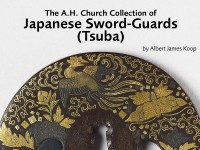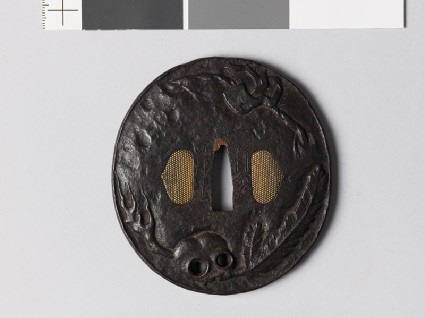The A. H. Church Collection of Japanese Sword-Guards (Tsuba)
An unpublished catalogue of the A. H. Church collection of Japanese sword-guards (tsuba) by Albert James Koop.

Publications online: 1264 objects
Tsuba with skull and New Year decorations
-
Literature notes
Slightly cupped; hammered-up edge; irregular, but polished surface modelled in low relief below with a skull (its eyes forming the udenuki holes) and an uprooted pine-sapling (kadomatsu), and above wih part of a shimenawa (twisted straw rope with pendants of cut paper, etc.); on the hollow back appear two other portions of the rope; peach-shaped ryōhitsu plugged with gilt metal of granulated surface (nanako).
Signed as no. 67 [EAX.10067] (the saku looks here like a later addition).
The kadomatsu and shimenawa are used for New Year decorations, and the design of this guard is thus in allusion to the famous poem of Ikkiu-osho (1394-1481):
Kadomatsu wa
meido no tabi no
ichiridzuka
medetaku mo ari
medetaku mo nashi
"The New Year pines,
yearly milestones in our dark,
journey through the world,
bring joy to some,
to others sorrow." -
Details
- Associated place
- Date
- 19th century (1801 - 1900)
- Material and technique
- iron, with hammered-up edge, carved decoration in low relief, and with polished surface (migaki-ji); gilt metal ryōhitsu plugs, with punched nanako decoration; tang-hole plugged with soft metal, probably copper
- Dimensions
- 9.3 x 8.7 cm (height x width)
- Material index
-
processed material › metal › iron,processed material › metal › gold,
- Technique index
- Object type index
-
arms/armour › koshirae › kodogu › tsuba
- No. of items
- 1
- Credit line
- Bequeathed by Sir Arthur H. Church, 1915.
- Accession no.
- EAX.10068
-
Further reading
Koop, Albert James, The A. H. Church Collection of Japanese Sword-Guards (Tsuba), 3 vols (Oxford, Ashmolean Museum, 1929), no. 68
Glossary
tsuba
-
tsuba
Japanese sword guard.
Location
-
- currently in research collection
Objects are sometimes moved to a different location. Our object location data is usually updated on a monthly basis. Contact the Jameel Study Centre if you are planning to visit the museum to see a particular object on display, or would like to arrange an appointment to see an object in our reserve collections.
Publications online
-

The A. H. Church Collection of Japanese Sword-Guards (Tsuba)
Slightly cupped; hammered-up edge; irregular, but polished surface modelled in low relief below with a skull (its eyes forming the udenuki holes) and an uprooted pine-sapling (kadomatsu), and above wih part of a shimenawa (twisted straw rope with pendants of cut paper, etc.); on the hollow back appear two other portions of the rope; peach-shaped ryōhitsu plugged with gilt metal of granulated surface (nanako).
Signed as no. 67 [EAX.10067] (the saku looks here like a later addition).
The kadomatsu and shimenawa are used for New Year decorations, and the design of this guard is thus in allusion to the famous poem of Ikkiu-osho (1394-1481):
Kadomatsu wa
meido no tabi no
ichiridzuka
medetaku mo ari
medetaku mo nashi
"The New Year pines,
yearly milestones in our dark,
journey through the world,
bring joy to some,
to others sorrow."
Notice
Object information may not accurately reflect the actual contents of the original publication, since our online objects contain current information held in our collections database. Click on 'buy this publication' to purchase printed versions of our online publications, where available, or contact the Jameel Study Centre to arrange access to books on our collections that are now out of print.
© 2013 University of Oxford - Ashmolean Museum

